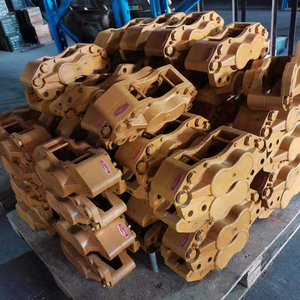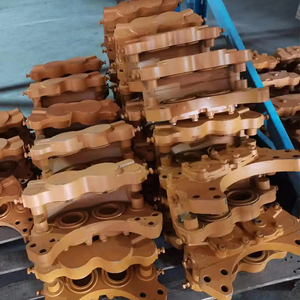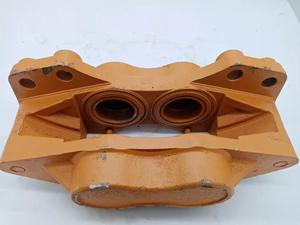
All categories
Featured selections
Trade Assurance
Buyer Central
Help Center
Get the app
Become a supplier

(1338 products available)













































A brake caliper boot is a small rubber or plastic cover that protects the piston of a brake caliper. It acts as a barrier against dirt, debris, dust, and moisture, which could compromise the brake caliper's functionality and, ultimately, the vehicle's braking performance. In addition, caliper boots reduce the risk of physical damage to brake calipers in off-road applications. Caliper boots come in different types, as discussed below.
1. Single Seal Brake Caliper Boot:
Single seal brake caliper boots have a simple design, typically consisting of a single cylindrical rubber or polymer sleeve. The boot fits over the piston and creates a seal between the brake caliper and the outside environment. Some single seal brake caliper boots have flanges or lips at the base to ensure the boot stays in place. These seals are ideal for most conventional vehicles and light-duty applications. They effectively keep contaminants out of the brake caliper. However, they might not provide sufficient protection against heavy-duty applications or extreme environmental conditions.
2. Double Seal Brake Caliper Boot:
A double seal brake caliper boot is similar to a single seal boot but has additional features that enhance its sealing capabilities. First, the boot has two cylindrical sleeves placed one inside the other. The outer sleeve acts as a pre-seal and protects the inner sleeve from contaminants. The inner sleeve forms a tight seal over the brake caliper piston. Double seal brake caliper boots are suitable for heavy-duty applications, such as trucks, buses, and off-road vehicles. They provide excellent protection against dust, debris, moisture, and other harmful substances.
3. Split Brake Caliper Boot:
Split brake caliper boots have a unique design that allows for quick and easy installation and removal. The boot is split into two halves, often with a zipper or Velcro closure along one side. This split design makes it unnecessary to disassemble the brake caliper or remove the brake line during installation. Split brake caliper boots are ideal for applications where frequent inspection or maintenance of the brake caliper is required. For instance, they are used in some high-performance vehicles, racing cars, or off-road vehicles. The split design provides added convenience, especially in critical applications where brake caliper performance is vital for safety and reliability.
4. Universal Brake Caliper Boot:
Universal brake caliper boots are designed to fit various brake caliper sizes and configurations. They come in different sizes and shapes to accommodate multiple vehicles and brake systems. Universal brake caliper boots are typically made from durable rubber or polymer materials suitable for most brake calipers. They offer a convenient and cost-effective solution for vehicles with worn-out or damaged caliper boots. However, the fit and sealing performance of universal brake caliper boots may vary depending on the specific brake caliper design and condition.
Brake caliper boots come in different sizes and types depending on the vehicle and the brake system used. Below are some common specifications of brake caliper boots:
Size
Caliper boots are available in different sizes to fit various brake calipers. The size is usually measured by the diameter and the length of the piston that the boot will cover.
Material
Caliper boots are commonly made from rubber or thermoplastic materials. Each of the materials has its own advantages. For instance, rubber is known for its elasticity and resistance to wear. On the other hand, thermoplastic is more durable and resistant to chemicals.
Shape
Caliper boots come in different shapes. The most common one is the cylindrical shape that is designed to fit over the brake caliper piston. Other shapes are wedges and cones.
Sealing Performance
Brake caliper boots are designed with sealing features to prevent dust and moisture from entering the brake system. The sealing features include lip rings and flanges.
Heat Resistance
Caliper boots are designed with heat-resistant features to allow them to withstand the high temperature generated during braking. The heat resistance is measured in temperature ranges.
Compatibility
Brake caliper boots are designed to be compatible with different types of brake calipers such as floating and fixed calipers. They are also designed to be compatible with various types of brake pads and brake discs.
Below are some common brake caliper boot maintenance practices:
Inspection
Regular inspection of brake caliper boots is important. During the inspection, look for signs of wear, damage, or cracking. The earlier the problem is detected the earlier it can be fixed.
Cleaning
Caliper boots should be cleaned regularly to remove dirt, debris, and dust that may have accumulated. The cleaning process involves using a soft brush and a mild detergent solution.
Lubrication
Brake caliper boots require occasional lubrication to maintain their elasticity and flexibility. During the lubrication process, use a silicone-based lubricant which is recommended by the manufacturer.
Proper Installation
During the installation of brake caliper boots, ensure that they are correctly fitted to avoid damage and wear. Follow the manufacturer's instructions on how to properly install caliper boots.
Replacement
Caliper boots will eventually wear out and therefore need to be replaced. When replacing the brake caliper boots, use caliper boots that are recommended by the manufacturer.
It is important to choose the right brake caliper boot for a vehicle. Here’s how to do it:
Consider the vehicle type:
The brake caliper boot should be suitable for the type of vehicle in which it will be installed. Larger vehicles such as trucks have more powerful brakes and generate more heat. They may require brake caliper boots that can withstand higher temperatures.
Check the size:
The size of the brake caliper boot should match the size of the caliper piston. It should form a tight seal around the piston without being stretched or loose. A properly fitting boot prevents dirt and moisture from entering and lubricates the brake caliper.
Consider the material:
The material of the brake caliper boot affects its durability and resistance to the brake fluid and heat. Common materials include rubber, silicone, and polyurethane. Each has its advantages. For example, silicone has excellent high-temperature stability, while polyurethane is more abrasion-resistant.
Evaluate the brand:
Buyers should choose brake caliper boots from reputable manufacturers. They should do some research and read reviews to find companies known for producing quality parts. The brand often indicates the reliability and longevity of the boot.
Check warranty:
A warranty gives buyers peace of mind. If the brake caliper boot fails due to defects, the manufacturer will replace it.
Replacing a brake caliper boot is a process that can be carried out at home with the right tools and basic mechanical knowledge. Here's a step-by-step guide on how to DIY and replace a brake caliper boot:
Tools and Materials Needed:
Step-by-step guide:
Q1: What is a brake caliper boot
A1. A brake caliper boot is a protective cover for the brake caliper. It prevents dirt, dust, and moisture from getting inside the brake caliper and interfering with its proper functioning.
Q2: What are the different types of brake caliper boots
A2. Brake caliper boots come in different types depending on the size and application. For instance, there are brake caliper piston boots, brake caliper seal boots, and universal brake caliper boot kits. They are all designed to protect brake caliper parts from damage.
Q3. Can people drive without a caliper boot
A3. A damaged brake caliper boot can compromise the brake caliper's functionality. If the brake caliper is not working properly, it can be unsafe to drive. Therefore, while there is no legal requirement to have a caliper boot, it is crucial for safety and road legality to have a functional brake caliper boot.
Q4: How long does a brake caliper boot last
A4. The brake caliper boot is designed to last long. However, its lifespan can be affected by several factors such as weather conditions, road conditions, and the quality of the boot itself. Generally, a brake caliper boot can last for 3 to 5 years. Remember to check the condition of the brake caliper boot periodically to avoid caliper damage.